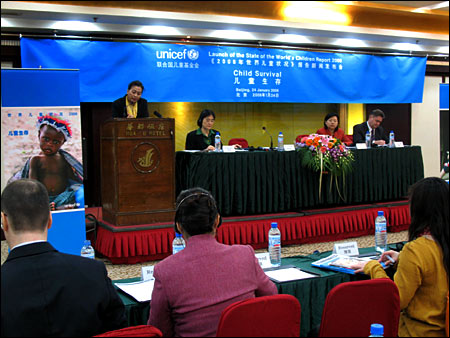China’s under-five death rate has almost halved since 1990, yet approximately 415,000 (4.3 percent) of 9.7 million children who perish around the globe each year reside in China. This figure rang alarm bells about child survival at the Chinese launch of UNICEF’s flagship report – The State of the World’s Children 2008.
“Further reduction in the number of deaths among children under five years of age may be in doubt if life-saving supplies integrated with regular health services are not made available to more children,” stated the UN’s children’s agency UNICEF’s flagship report The State of the World’s Children 2008: Child Survival.
According to the report, the annual number of child deaths has been halved, from roughly 20 million in 1960 to 9.7 million in 2006. “Despite progress, the world in not yet on track to achieve the Millennium Development Goal target of a two-thirds reduction in child mortality rates by the year 2015,” warned Dr. Hans Anders Troedsson, a representative for the World Health Organization’s (WHO) China branch at the Beijing launch, two days after its global launch in Geneva.
The report also emphasized several basic strategies that could help reduce the number of children who die before their fifth birthday. The document described the impact of interventions such as exclusive breastfeeding, immunizations, insecticide-treated bed nets and vitamin A supplementation, all of which have helped to reduce child mortality in recent years.
“Integrated delivery of these interventions and their promotion or inclusion through routine community health services for mothers and their young children increases their coverage and probability of positive impact even more,” said Ann M. Veneman, UNICEF executive director, at the Geneva launch for the annual report.
Another UNICEF Representative in China, Dr. Yin Yin New, noted on Tuesday, “The report advocates combining high-impact, disease specific interventions - such as exclusive breastfeeding and vitamin A supplementation – with investment in strong national health care systems in order to deliver a continuum of maternal and child health care in villages via local clinics and hospitals.”
“It should be highlighted that China has made encouraging progress since 1990 as the under-five mortality rate of the country has almost halved,” said Dr. Troedsson, “but there is still bad news: China’s newborn and maternal mortality rates in remote rural areas is two to five times higher than that in urban areas.”
He added that unnecessary deaths among children and their mothers occur among a large group of the migrant population. “Now that we have the acknowledgment, a lot of things must be done to turn this acknowledgment into action,” advocated Dr. Troedsson.
Statistics from the Ministry of Health (MOH) of China show that the infant mortality rate in China was 17 per thousand in 2006, less than the average number of other developing countries (54), but over triple the average of developed countries, according to the report.
The 2006 Joint Review of the Maternal and Child Survival Strategy in China conducted by MOH with support from UNICEF, WHO and the UN Population Fund stated that many of China’s remaining preventable young child deaths occur in poor, remote areas where access to and uptake of quality services are lacking. In addition to lack of such access caused by geographic reasons, health services are out of reach of poor rural families and also unavailable to many migrants in urban areas.
For instance, hospital delivery coverage in Guizhou and the Tibet Autonomous Region, two underdeveloped in western China, is 51 and 36 percent respectively, said Wang Linhong, deputy director of the National Center for Women and Children’s Health of China CDC, at the Tuesday launch.
Dr. Shi Qi from the Department of Maternal and Children Health Care and Community Health under the MOH said that almost all the central budgetary appropriations for medical uses in recent years were invested in western regions, and the MOH’s working priority is targeting western regions at present.
A long-term program jointly initiated by the MOH and the Ministry of Commerce of China in 2000 was carried out in western provinces and autonomous regions to help reduce the child mortality rates and maternal mortality, explained Dr. Shi Qi at the launch. She said that thanks to this program and other endeavors maternal and child mortality rates in rural areas have declined more rapidly than those in urban areas.
(China.org.cn by Zhang Tingting January 25, 2008)


